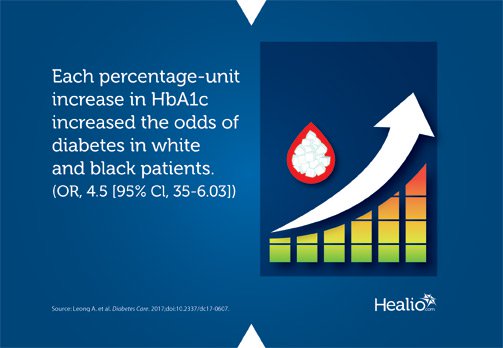HbA1c predicts type 2 diabetes in black, white patients
HbA1c is a useful tool for assessing type 2 diabetes risk in both white and black patients, according to findings recently published in Diabetes Care.
“Although fasting glucose has been the traditional method for assessing [type 2 diabetes] risk, HbA1c has several advantages: It reflects average glucose exposure over time, can be determined in nonfasting patients, has low intraindividual variability and low analytic variability, and has been standardized across laboratories worldwide,” Aaron Leong, MD, MSc, of Harvard Medical School, and colleagues wrote. “Despite these advantages, the utility of measuring HbA1c for assessing [type 2 diabetes] risk in various clinical and nonclinical settings has not been thoroughly evaluated.”
The researchers conducted a prospective cohort study of 11,244 white participants and 2,294 black participants from the Framingham Heart Study and Atherosclerosis Risk in Communities study. No patients had diabetes at baseline. Leong and colleagues evaluated associations between HbA1c and type 2 diabetes with regression models, adjusting for age and sex; fasting glucose, HDL and triglycerides; blood pressure, BMI and family diabetes history; or all covariates.
Type 2 diabetes developed among 3,315 patients over the course of 20 years, the researchers reported. Each percentage-unit increase in HbA1c produced a fourfold increase in the odds of developing diabetes, according to Leong and colleagues. This held true for both black (OR = 4; 95% CI, 3.14-5.1) and white (OR = 4.73; 95% CI, 3.1-7.21) patients, with a combined OR of 4.5 (95% CI, 3.35-6.03).
After the researchers adjusted for fasting laboratory tests and clinical data, they reported a combined OR of 2.68 (95% CI, 2.15-3.34) over the course of 20 years, 2.23 (1.94-2.57) after 8 years and 5.79 (95% CI, 2.51-13.36) within 8 years.
“HbA1c is a useful tool for short-term and long-term risk prediction, in itself, and in situations where more clinical information, including fast measures, is available,” the researchers wrote. “This accurate and convenient test has a central place in [type 2 diabetes] prevention efforts nationally and worldwide.” – by Andy Polhamus
Disclosures: Leong reports no relevant financial disclosures. The study was funded by Quest Diagnostics. Please see the study for a complete list of all other authors’ relevant financial disclosures.

